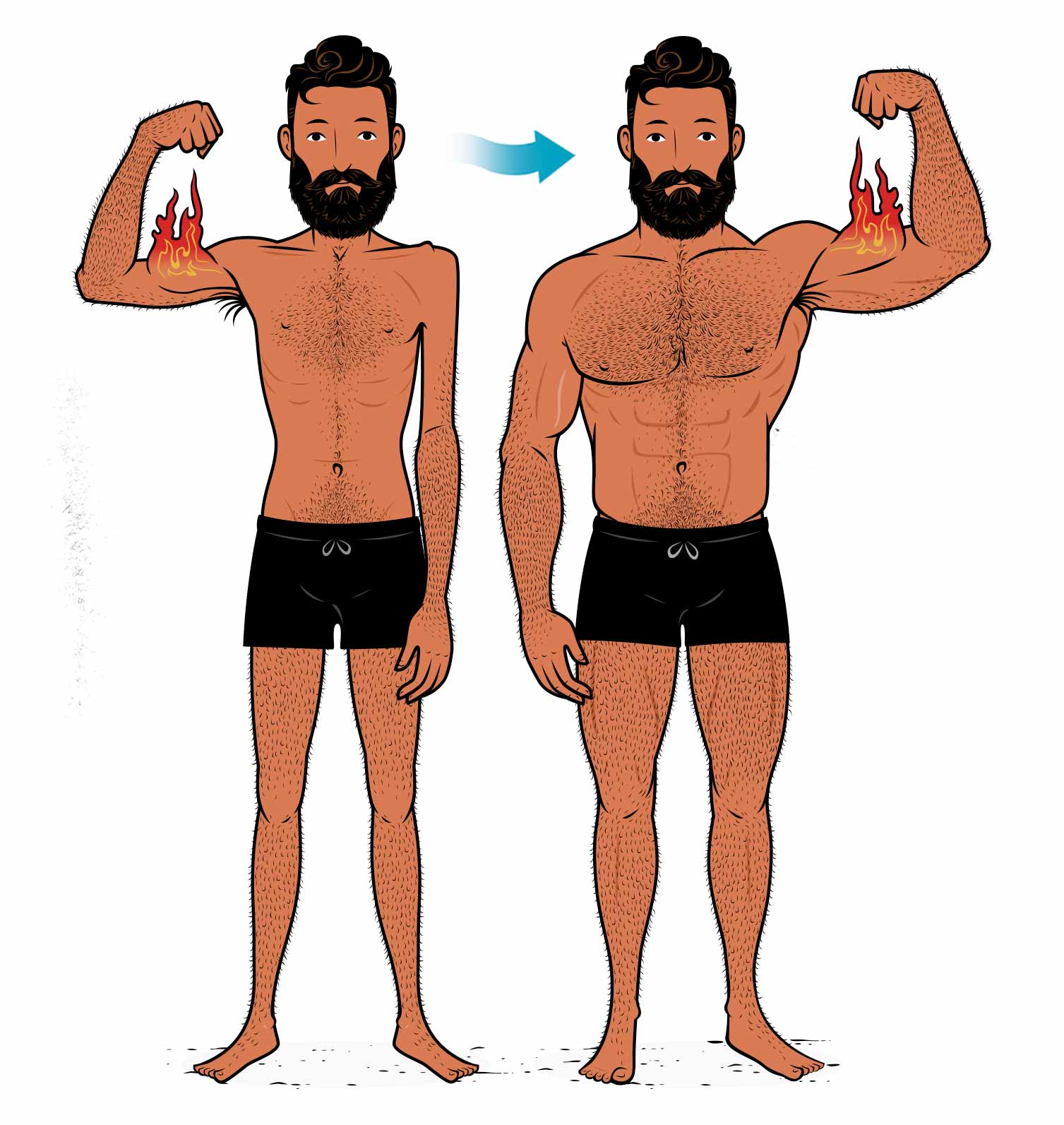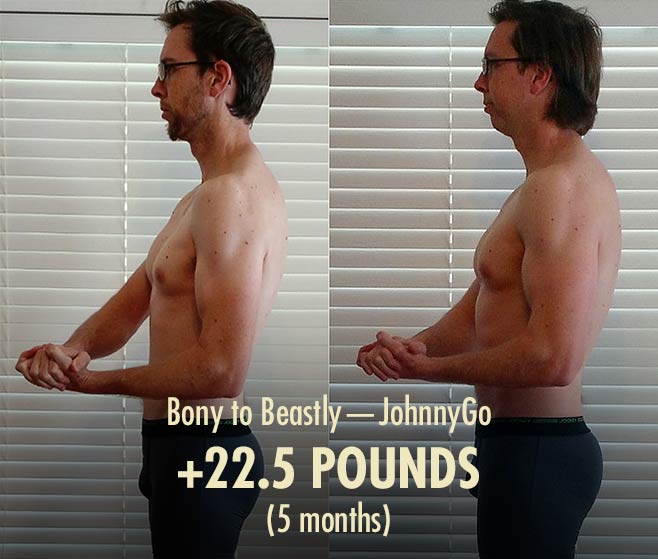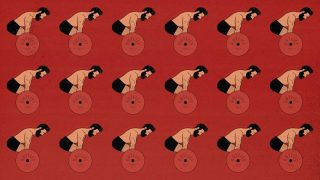
How to Do Giant Sets
Giant sets are one of the best methods for gaining both muscle size and strength. They aren’t better than straight sets or supersets, but they are more efficient, allowing you to stimulate more muscle growth in a given amount of time.
Giant sets are also great for your overall health and conditioning. Because you aren’t resting very long between each set, your cardiovascular system is getting a hearty workout, too. And because each individual muscle is still getting plenty of rest before being worked again, giant sets are still great for gaining muscle size and strength.
So, what are giant sets? And what’s the best way to program them?

What Are Giant Sets?
A giant set is when several different exercises are done one after the other, as a circuit. They’re like supersets, just with more exercises. For example, if you do a set of squats, then a set of chin-ups, then a set of push-ups, and then a set of crunches. That’s a giant set.
Here’s how a giant set might look:
- Squats, set #1.
- Chin-ups, set #1.
- Push-ups, set #1.
- Crunches, set #1.
- Rest for 2 minutes.
Then you’d do a second giant set:
- Squats, set #2.
- Chin-ups, set #2.
- Push-ups, set #2.
- Crunches, set #2.
- Rest for 2 minutes.
And a third:
- Squats, set #3.
- Chin-ups, set #3.
- Push-ups, set #3.
- Crunches, set #3.
The idea is to do circuits of exercises that all work different muscles. Squats for your legs, chin-ups for your back, push-ups for your chest, and then crunches for your abs. Then, once you’ve worked your entire body, you rest for a couple of minutes, do a second giant set, then a third.
What Are Giant Sets For?
Giant sets allow you to do more sets in less time while still giving your muscles enough rest (study, study, study). They’re a great way to make your workouts harder, denser, and much, much shorter.
Let’s go over an example. Let’s say you’re doing a typical full-body hypertrophy workout, resting for 1–5 minutes between most of your sets.
Squats: 3 sets of 8 repetitions:
- Set 1: rest for 5 minutes
- Set 2: rest for 5 minutes
- Set 3: rest for 5 minutes
Chin-Ups: 3 sets of as many reps as possible (AMRAP)
- Set 1: rest for 3 minutes
- Set 2: rest for 3 minutes
- Set 3: rest for 3 minutes
Bench Press: 3 sets of 8 repetitions
- Set 1: rest for 3 minutes
- Set 2: rest for 3 minutes
- Set 3: rest for 3 minutes
Crunches: 3 sets of AMRAP
- Set 1: rest for 1 minute
- Set 2: rest for 1 minute
- Set 3: done
Length of your workout: 47 minutes
Assuming it takes you around a minute to do each set, this workout would take you around 47 minutes. Add in some warm-ups and setup time, and you’re looking at over an hour. And that’s not even a particularly long workout. You’re only doing four exercises and just 3 sets per exercise.
You could cut those rest times down to 1–2 minutes between sets, but that’s probably not enough time for your muscles to rest, especially if you’re strong. Your performance would suffer on subsequent sets. Maybe you get 8 reps on your first set, 5 in your second, and 3 in your third. That’s not the end of the world, but it’s not quite ideal, either. If you’re always rushing, it can cut into your training volume. Less volume means less muscle growth (at least to a point).
Now let’s reimagine the workout using giant sets. Let’s say you’re doing your entire workout in a power rack. Maybe you’re like me, and that’s all you have in your home gym. Or maybe you’re training at a commercial gym, and you don’t want to use up too much equipment all at once. So we swap out the bench press for push-ups. That gives us a workout like this:
Giant set 1:
- Squats: rest a minute
- Chin-ups: rest a minute
- Push-ups: rest a minute
- Crunches: rest a minute
Giant set 2:
- Squats: rest a minute
- Chin-ups: rest a minute
- Push-ups: rest a minute
- Crunches: rest a minute
Giant set 3:
- Squats: rest a minute
- Chin-ups: rest a minute
- Push-ups: rest a minute
- Crunches: done
Length of your workout: 23 minutes
With these giant sets, you’ve done the same number of exercises and sets, but you’ve done them in half the time. You’ll also be maintaining a higher heart rate, which is great for improving your cardiovascular health and general fitness. The real question, though, is whether there’s any tradeoff in muscle or strength gains.
Are Giant Sets Good for Building Muscle?
There isn’t that much research looking specifically at giant sets (study), but there are two good studies looking at supersets (study, study, study). Since giant sets and supersets are so similar, I think it’s fair to assume that giant sets are similarly good for building muscle.

For example, in a study by Paz et al., the participants did the bench press and the row, alternating between the two exercises for three sets each. Set 1: bench, row, rest. Set 2: bench, row, rest. Set 3: bench, row, rest. As the sets went on, the participants doing supersets started getting better muscle activation than the group doing straight sets.
The reason the superset group did so well is that they were training opposing (antagonist) muscle groups. The bench press trains the chest and triceps. The row trains the back and biceps. As one muscle group gets tired, it gets easier to engage the opposite muscle group. Or so the theory goes. It’s not a big difference in muscle activation, and I’m not sure it would result in any differences in muscle growth.
With giant sets, you can use that same technique, combining rows and push-ups, squats and leg curls. But you don’t have to. As long as you choose exercises that train different muscle groups, you should do just fine. You should gain a similar amount of muscle and strength as if you were doing straight sets.
How to Program Giant Sets
There are a few different ways of doing giant sets. Some of them are better than others, but a lot of it comes down to how much time you have and what your specific goals are.
- Doing your entire workout as a giant set: in the above examples, we’ve combined four different exercises into a giant set. Those four exercises work most of the big muscles in your body. If you’re pressed for time, that could be your entire workout. It’s not totally min-maxed, but you’d gain tons of muscle that way.
- Doing your isolation lifts as giant sets: another approach is to take a simpler approach with your big compound lifts, like the squat, bench press, chin-up, and deadlift. You’d do those exercises as straight sets or supersets, putting all the emphasis on progressive overload. After that, combine all of your isolation lifts into a giant set. For instance, you’d start an upper-body workout with the bench press and barbell row, then do 3 giant sets of biceps curls, triceps extensions, lateral raises, and reverse flyes. That way you get in some quality work with your compound lifts, then quickly blast through your smaller isolation lifts. This is how I built most of my muscle mass.
- Bodybuilder giant sets: these blast specific muscles with back-to-back sets. For example, you could do the bench press, then a set of push-ups, and then a set of dumbbells flyes. These are fine for building muscle (study), but drop sets accomplish the same thing, they’re simpler, they don’t require as much equipment, and they have more research proving their effectiveness (study, study).
In most of our programs, we use a mix of straight sets, supersets, and giant sets. The trick is to find exercises that don’t interfere with one another, either by working the same muscles or requiring too many pieces of equipment. That’s why exercises like squats, chin-ups, push-ups, and crunches work so well together. All you need is a power rack and a single barbell.
If you have dumbbells, doing giant sets of isolation lifts can also work quite well. Just be flexible with your rep ranges. Maybe you grab a 25-pound dumbbell and use it for some incline curls, overhead triceps extensions, and lateral raises, doing as many reps as you can for each exercise.
What Kind of Results Can You Expect?
In our Bony to Beastly and Bony to Bombshell programs, we use a mix of supersets and giant sets. We do supersets for our compound lifts (such as goblet squats + push-ups), giant sets for our isolation lifts (such as planks, biceps curls, and triceps extensions). That way our members can do a min-maxed program inside of an hour. And then as a side benefit, it’s also great for improving general fitness.

Most members are able to make consistent progress on their compound lifts, getting gradually stronger over time. And they’re able to get in quite a lot of volume on their isolation lifts, allowing them to bulk up the muscles they’re most eager to grow. In Johnny’s case, he got stronger at the bench press, chin-up, squat, and deadlift while also bulking up his arms and shoulders with isolation lifts.

In Ioulia’s case, she got stronger at squats, Romanian deadlifts, push-ups, chin-ups, and glute bridges while still having time for plenty of hip thrusts and planks. That’s how she was able to bring up her target muscles (her glutes) while gaining a ton of muscle and strength overall.
Summary
Giant sets stimulate a similar amount of muscle growth to straight sets, but in a fraction of the time. You can cut the length of your workouts in half with very few downsides. There’s nothing magic about them, it’s just a way of better managing your rest times.
The trick is to make sure that doing giant sets isn’t interfering with progressive overload, especially on your big compound lifts. If you’re having trouble getting stronger at your main lifts, maybe do them as straight sets or supersets. Maybe save your giant sets for the smaller isolation lifts.

We try to take advantage of giant sets in all of our programs, Marco uses them to train professional and Olympic athletes, and I’ve been using them for the past 10 years in my own training. They’re always optional, though, and there’s never any harm in doing straight sets. Giant sets are just an option to keep in mind.

If you want more muscle information about gaining muscle and strength, we have a free muscle-building newsletter for skinny guys and for thin women. If you want a full foundational bulking program, including a 5-month full-body workout routine, diet guide, recipe book, and online coaching, check out our Bony to Beastly Bulking Program (for men) or Bony to Bombshell Program (for women). And if you’re an intermediate lifter who want to continue getting bigger and stronger, check out our Intermediate Muscle-Building Program.




Guys, you really rock. Combining and cycling straight sets with longer rest with “advanced” sets featuring shorter rest intervals breaks through plateaus and keeps it exciting. The excitement is not mentioned in the literature, although, granted, it would be hard to operationalize.
Thanks, Jim! I totally agree. Mixing up training variables can keep things fresh and help us bust through plateaus. I do the same thing.
qzsdk3
“Length of your workout” doesn’t add up in both examples.
Also in example of Squats you say:
Set #1, rest 5 minutes
Set #2, rest 5 minutes
Set #3, rest 5 minutes
Rest after last set (#3) is not necessary, because next exercise is chin up. Maybe short rest to catch a breath is needed but 5 min is too much.
Hm. How are you doing your math? With that example, I’d calculate it like this:
Set 1 takes about a minute.
Rest 5 minutes.
Set 2 takes about a minute.
Rest 5 minutes.
Set 3 takes about a minute.
Rest 5 minutes.
Then, during that final 5 minutes of rest, you’re putting your weights away, setting up the next exercise, and doing a warm-up set or two.
That adds up to 18 minutes all told. If we do that for all the exercises, we get 47 minutes.
It’s not supposed to be precise. We aren’t machines. It will inevitably take longer. But the point still holds.